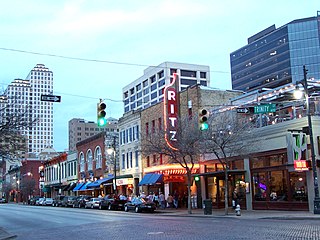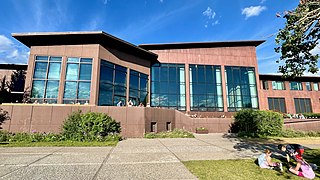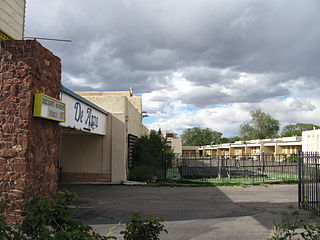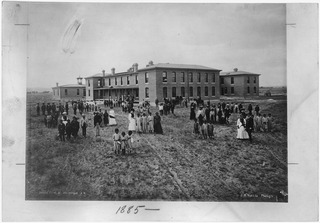
Scouting in New Mexico has had a rich and colorful history, from the 1910s to the present day, serving thousands of youth in programs that suit the environment in which they live. The state is home to the Philmont Scout Ranch.

Lebanon (/ˈlɛbnən/) is a city in and the county seat of Boone County, Indiana, United States. The population was 15,792 at the 2010 census. Lebanon is located in central Indiana, approximately 29 miles (47 km) northwest of downtown Indianapolis and 36 miles (58 km) southeast of Lafayette.

Timberline Lodge is a mountain lodge on the south side of Mount Hood in Clackamas County, Oregon, about 60 miles (97 km) east of Portland. Constructed from 1936 to 1938 by the Works Progress Administration, it was built and furnished by local artisans during the Great Depression. Timberline Lodge was dedicated September 28, 1937, by President Franklin D. Roosevelt.

Multnomah Falls is a waterfall located on Multnomah Creek in the Columbia River Gorge, east of Troutdale, between Corbett and Dodson, Oregon, United States. The waterfall is accessible from the Historic Columbia River Highway and Interstate 84. Spanning two tiers on basalt cliffs, it is the tallest waterfall in the state of Oregon at 620 ft (189 m) in height. The Multnomah Creek Bridge, built in 1914, crosses below the falls, and is listed on the National Register of Historic Places.

Bandelier National Monument is a 33,677-acre (13,629 ha) United States National Monument near Los Alamos in Sandoval and Los Alamos counties, New Mexico. The monument preserves the homes and territory of the Ancestral Puebloans of a later era in the Southwest. Most of the pueblo structures date to two eras, dating between 1150 and 1600 AD.

Sixth Street is a historic street and entertainment district in Austin, Texas, located within the city's urban core in downtown Austin. Sixth Street was formerly named Pecan Street under Austin's older naming convention, which had east–west streets named after trees and north–south streets named after Texas rivers.

Battleground National Cemetery is a military burial ground, located along Georgia Avenue near Fort Stevens, in Washington, D.C.'s Brightwood neighborhood. The cemetery is managed by the National Park Service, together with other components of Rock Creek Park.

The historic U.S. Route 66 ran east–west across the central part of the state of New Mexico, along the path now taken by Interstate 40 (I-40). However, until 1937, it took a longer route via Los Lunas, Albuquerque, and Santa Fe, now roughly New Mexico State Road 6 (NM 6), I-25, and US 84. Large portions of the old road parallel to I-40 have been designated NM 117, NM 118, NM 122, NM 124, NM 333, three separate loops of I-40 Business, and state-maintained frontage roads.

Jackson Lake Lodge is located near Moran in Grand Teton National Park, in the U.S. state of Wyoming. The lodge has 385 rooms, a restaurant, conference rooms, and offers numerous recreational opportunities. The lodge is owned by the National Park Service, and operated under contract by the Grand Teton Lodge Company. The Grand Teton Lodge Company also manages the Jenny Lake Lodge, as well as cabins, restaurants and other services at Colter Bay Village. The lodge is located east of Jackson Lake adjacent to prime moose habitat below the Jackson Lake Dam.

The Mother Mosque of America, once known as The Rose of Fraternity Lodge, in Cedar Rapids, Iowa, United States, is the oldest standing purpose-built mosque in the United States, having been completed in 1934. The Al-Sadiq Mosque in Chicago and the Powers Street Mosque are older by a decade but were converted from existing buildings to be used as a Muslim house of worship.

The Grand Canyon Lodge is a hotel and cabins complex at Bright Angel Point on the North Rim of the Grand Canyon. It was designed by Gilbert Stanley Underwood, who designed a number of other hotels in national parks for the Utah Parks Company and other concessioners. Built in 1927–28, the Grand Canyon Lodge resort complex consists of the Main Lodge building, 23 deluxe cabins, and 91 standard cabins, some of which were moved to the north rim campground in 1940. All guests are housed in cabins detached from the main lodge, which serves as a dining, concessions and service facility. Constructed of native Kaibab limestone and timber, the complex was designed to harmonize with its rocky and forested setting. The Grand Canyon Lodge complex is notable for its setting and rustic design, as well as its status as the only complete surviving lodge and cabin complex in the national parks.

Crater Lake Lodge is a hotel built in 1915 to provide overnight accommodations for visitors to Crater Lake National Park in southern Oregon, US. The lodge is located on the southwest rim of the Crater Lake caldera overlooking the lake 1,000 feet (300 m) below. The lodge is owned by the National Park Service, and is listed on the National Register of Historic Places. In 2022, the hotel is a Historic Hotels of America program member, and has been so since 2012.
Big Bead Mesa is a historic Navajo habitation site near Grants, New Mexico, within Cibola National Forest. Occupied from the mid-18th to early 19th century, the site gives an important window into the relations between the Navajo and the Puebloans of that time. First explored archaeologically in 1939, it was declared a National Historic Landmark in 1964.

The Chickasaw Council is a local council of the Boy Scouts of America that serves Scouts in Shelby County, Tennessee, as well as Crittenden county in eastern Arkansas and fifteen counties in northwest Mississippi. It was founded on February 22, 1916, to oversee the many Boy Scout troops already present in Memphis, Tennessee. The Chickasaw Council has two camps: Kia Kima Scout Reservation and Camp Currier. The Chickasaw Council is also home to the Order of the Arrow Ahoalan-Nachpikin Lodge 558.

The Willimantic Elks Club is a historic Elks lodge at 198 Pleasant Street in the Willimantic section of Windham, Connecticut. Built in 1925 for a lodge founded in 1914, it is one of the finest examples of Tudor Revival architecture in the region, and has been a major site of social events in the community since. The building was added to the National Register of Historic Places in 2005.

The De Anza Motor Lodge was a historic motel located on former U.S. Route 66 in the Upper Nob Hill neighborhood of Albuquerque, New Mexico. It was built in 1939 by Charles G. Wallace, a local trader of Zuni art and pottery, who remained the owner until 1983. Wallace decorated the motel with a variety of Native American art, including a series of murals by Zuni artist Tony Edaakie in a basement room.

Lacey-Keosauqua State Park is located southwest of Keosauqua, Iowa, United States. The park is located along the Des Moines River in Van Buren County. First dedicated in 1921, it is the largest state park in size in Iowa. In 1990, three areas were named nationally recognized historic districts and listed on the National Register of Historic Places.

Albuquerque Indian School (AIS) was a Native American boarding school in Albuquerque, New Mexico, which operated from 1881 to 1981. It was one of the oldest and largest off-reservation boarding schools in the United States. For most of its history it was run by the Bureau of Indian Affairs (BIA). Like other government boarding schools, AIS was modeled after the Carlisle Indian Industrial School, using strict military-style discipline to strip students of their native identity and assimilate them into white American culture. The curriculum focused on literacy and vocational skills, with field work components on farms or railroads for boys and as domestic help for girls. In the 1930s, as the philosophy around Indian education changed, the school shifted away from the military approach and offered more training in traditional crafts like pottery, weaving, and silversmithing.


















